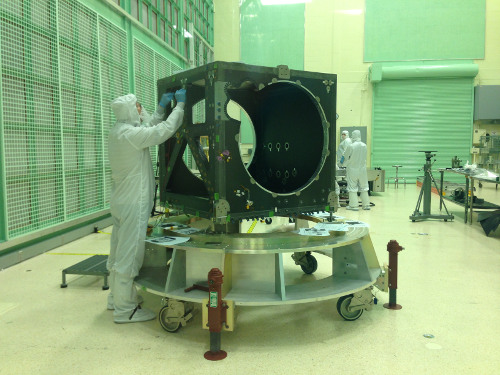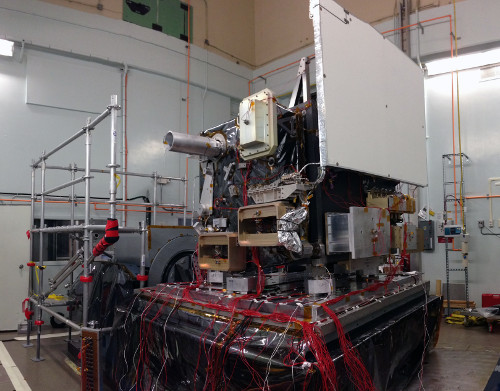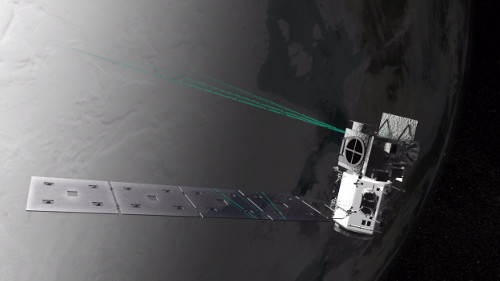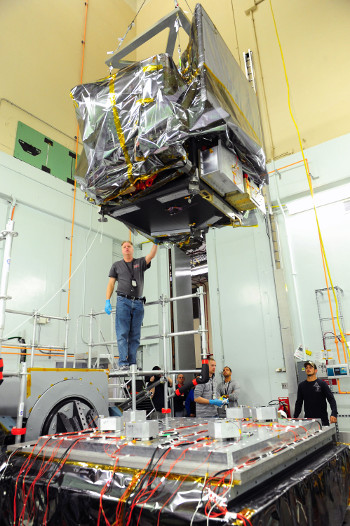 |
| December 02, 2014 | Volume 10 Issue 45 |
Designfax weekly eMagazine
Archives
Partners
Manufacturing Center
Product Spotlight
Modern Applications News
Metalworking Ideas For
Today's Job Shops
Tooling and Production
Strategies for large
metalworking plants
Inside Look: How NASA builds a space laser
By Kate Ramsayer, NASA's Goddard Space Flight Center, Greenbelt, MD

An engineer checks ICESat-2's box structure, shortly after its arrival in a NASA clean room in May 2014. Over the next two years, engineers and technicians will attach electronics, optics, lasers, a telescope, and more to the box, testing its function at each step. [Image Credit: NASA's Goddard Space Flight Center/Kate Ramsayer]
To build a satellite that will measure all the bumps and dips of our dynamic Earth, engineers started with a black box, built of a composite honeycomb material to make it as light as possible.
The structure was precisely manufactured with an opening to allow lasers to beam to Earth, and other windows sized for a telescope that will capture photons that bounce off our planet and return to the satellite. The box was measured and marked to denote where the assembly of aligned mirrors, electronics, lasers, and photon detectors would be attached. It must be tough enough to handle the rigors of a rocket launch and years in a harsh space environment; here on Earth, the box structure must be hardy enough to withstand tests engineers use to simulate those conditions.
The box structure at the core of the Ice, Cloud and land Elevation Satellite-2, or ICESat-2, instrument was delivered to a clean room at NASA's Goddard Space Flight Center in Greenbelt, MD, in May. A team of 250 engineers, fabricators, and scientists has now started the official integration and testing stage of the laser instrument.
"There's lots of activity, we're moving from looking at all the different subsystems, to looking at the overall system coming together. It's really exciting to move forward into that realm," said Cathy Richardson, instrument manager with the ICESat-2 mission. The team had a half-dozen components ready for delivery in June. "It's not just a drawing. It's an actual, real piece of hardware that's getting tested and showing that it's meeting requirements."

The ATLAS box structure, in preparation for its vibration tests, which will ensure the box can withstand the jolts of launch. To test the box structure, the team attached mass simulators to stand in for components that will be delivered later, including the star tracker and lasers. [Image Credit: NASA's Goddard Space Flight Center/Kate Ramsayer]
ATLAS assembly
ICESat-2's instrument, called the Advanced Topographic Laser Altimeter System, or ATLAS, will measure the elevation of Earth's surfaces, from ice sheets to forests to oceans. Its six beams will generate a more detailed elevation portrait than the single beam of the original ICESat, which flew from 2003 to 2009. And with the beams paired, scientists will be able to measure surface slope and better calculate height changes.
To measure elevation, ATLAS beams light with a green laser that pulses 10,000 times a second. Only a few photons will bounce off the surface and return to the satellite, but an incredibly sensitive detector counts those that do come back. Using the time of the photons' return trip, the speed of light and some geometry, scientists can determine the distance the photons traveled and, therefore, the height of Earth below the satellite's orbit.
ATLAS will provide scientists with measurements that create a global portrait of Earth's elevation, and will gather data that can precisely track change, including melting glaciers and thinning sea ice.
"ICESat-2 will revolutionize our understanding of ice sheet and sea ice changes and processes," said Thorsten Markus, ICESat-2 project scientist. "I think it's one of the most exciting missions out there. There's so much opportunity for real discoveries."
The satellite will observe Earth in a new way, he said, which makes it technically challenging. But this also opens the door for discoveries not yet imagined. After years of calculations and computer models and discussions, Markus said, it's exciting to see the hardware come together.
Video: This video describes how scientists can use satellite-based lasers to study planet terrain, like the mountains and craters of other worlds, or the forests and ice cover on our own Earth. [Image Credit: NASA's Goddard Space Flight Center]
In addition to the box structure -- the body of the satellite -- the ATLAS team has also built the instrument's optical bench. The bench is a rectangular platform on which the lasers, mirrors, fiber optic cables, a star-tracker and more will be attached precisely into place. The precision is key; there's little leeway for photons to go astray.

This artist's concept shows a representation of ICESat-2 and its six-beam scanning pattern. [Image Credit: NASA's Goddard Space Flight Center]
"Our whole job on the optical bench is to align everything -- it's critical," said Carol Lilly, Integration and Testing Lead for ATLAS at Goddard. Before even leaving the instrument, the green laser bounces off a number of mirrors and is split into six beams. When they return to the satellite's telescope, those photons have to bounce off mirrors and hit optical fibers less than one-one hundredth of an inch (half-millimeter in diameter) -- or else they aren't counted.
"If any of the optics move too much and we can't stay aligned, the science measurements can't be made," Richardson said. Teams will work on the ATLAS box structure and its optical bench simultaneously, to increase efficiency.
Still, the real key to building a satellite, Lilly noted, is to assemble a team of talented engineers and technicians. "The people here doing the work are really experts in what they do and are really talented," she said. "It wouldn't work nearly as well as it does around here if we didn't have these expert technicians doing the job."
Putting it to the test
Each instrument component is put through environmental testing before it's delivered to the ATLAS clean room at Goddard, so that if something doesn't pass one of the tests it can be fixed.

A crew guides the ATLAS box structure onto the shaker table in a vibration chamber at Goddard's Integration and Testing Facility. The box structure went through a number of tests, including thermal cycling and acoustic, before being delivered for Integration and Testing. [Image Credit: NASA's Goddard Space Flight Center/Debbie McCallum]
"You test as you fly," Lilly said. To simulate launch conditions, a vibration chamber will shake the components while a separate test will blast them with sound. To simulate space, the components will be subjected to temperature extremes in Goddard's thermal vacuum chambers and to electromagnetic interference.
The box structure and optical bench were put through their own testing in April. The ATLAS team outfitted the structures with weights to simulate the mass of the components and then tested their response to hot and cold temperatures. They ended with an extended hot period called a "bake-out" to burn off potentially contaminating chemicals in the adhesives.
During the vibration test, the crew carefully lowered the joined box and bench onto a shaker table and bolted it in place. They jolted it in several directions, monitoring any damage with a tangle of red wires affixed to certain points. When the testing was complete, the crew taped up exposed or sharp areas, so that the harness and other components wouldn't catch. They hooked up several small heaters, which will keep ATLAS at a constant temperature, and installed posts where wires and cables and more will attach.
Engineers are assembling and testing other components in buildings across the Goddard campus. In March, the 2.6-ft (0.8-m), 46-lb (20.8-kg) telescope arrived. The telescope captures the photons returning from Earth and focuses them on the fibers that lead to the detector. It's made of beryllium, a light material that minimally expands or contracts in the changing temperatures ATLAS will experience in orbit.
With testing equipment such as lasers and mirrors, engineers will check the telescope's focus, the size of the spots photons focus on, and other optical properties. After testing it at room temperature, the team will move the telescope assembly to a thermal vacuum chamber, where they will fire a laser and test the telescope at temperature extremes -- from minus 22 to 122 F (minus 30 to 50 C).
Five new NASA Earth science missions are launching in 2014 to expand our understanding of Earth's changing climate and environment.
"It has to work at all temperatures," said Bente Eegholm, ATLAS's receiver telescope assembly lead.
The telescope and most of the other components were delivered to the clean room this fall, Richardson said; the lasers themselves will come later. And by November 2016, the team is scheduled to have ATLAS completed and tested, ready to ship to Orbital Science Corp. in Arizona. There, ATLAS will be attached to the spacecraft bus, and the entire ICESat-2 will be shipped to Vandenberg Air Force Base in California for launch.
For more information on ICESat-2, visit: http://icesat.gsfc.nasa.gov/icesat2/
Published December 2014
Rate this article
View our terms of use and privacy policy
